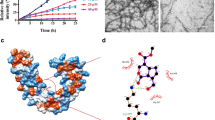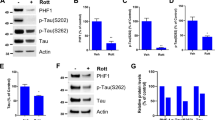Abstract
Rationale
Tau hyperphosphorylation and aggregation is considered as a main pathological mechanism underlying Alzheimer’s disease (AD). Rose Bengal (RB) is a synthetic dye used for disease diagnosis, which was reported to inhibit tau toxicity via inhibiting tau aggregation in Drosophila. However, it was unknown if RB could produce anti-AD effects in rodents.
Objectives
The research aimed to investigate if and how RB could prevent β-amyloid (Aβ) oligomers-induced tau hyperphosphorylation in rodents.
Methods and results
RB was tested in vitro (0.3–1 μM) and prevented Aβ oligomers-induced tau hyperphosphorylation in PC12 cells. Moreover, RB (10–30 mg/kg, i.p.) effectively attenuated cognitive impairments induced by Aβ oligomers in mice. Western blotting analysis demonstrated that RB significantly increased the expression of pSer473-Akt, pSer9-glycogen synthase kinase-3β (GSK3β) and reduced the expression of cyclin-dependent kinase 5 (CDK5) both in vitro and in vivo. Molecular docking analysis suggested that RB might directly interact with GSK3β and CDK5 by acting on ATP binding sites. Gene Ontology enrichment analysis indicated that RB might act on protein phosphorylation pathways to inhibit tau hyperphosphorylation.
Conclusions
RB was shown to inhibit tau neurotoxicity at least partially via inhibiting the activity of GSK3β and CDK5, which is a novel neuroprotective mechanism besides the inhibition of tau aggregation. As tau hyperphosphorylation is an important target for AD therapy, this study also provided support for investigating the drug repurposing of RB as an anti-AD drug candidate.





Similar content being viewed by others
References
Ali T, Kim MO (2015) Melatonin ameliorates amyloid beta-induced memory deficits, tau hyperphosphorylation and neurodegeneration via PI3/Akt/GSk3β pathway in the mouse hippocampus. J Pineal Res 59(1):47–59. https://doi.org/10.1111/jpi.12238
Aragão Gomes L, Uytterhoeven V, Lopez-Sanmartin D, Tomé SO, Tousseyn T, Vandenberghe R et al (2021) Maturation of neuronal AD-tau pathology involves site-specific phosphorylation of cytoplasmic and synaptic tau preceding conformational change and fibril formation. Acta Neuropathol 141(2):173–192. https://doi.org/10.1007/s00401-020-02251-6
Busche MA, Hyman BT (2020) Synergy between amyloid-β and tau in Alzheimer’s disease. Nat Neurosci 23(10):1183–1193. https://doi.org/10.1038/s41593-020-0687-6
Chen L, Pan H, Bai Y, Li H, Yang W, Lin ZX, et al. (2020) Gelsemine, a natural alkaloid extracted from Gelsemium elegans Benth. alleviates neuroinflammation and cognitive impairments in Aβ oligomer-treated mice. Psychopharmacology (Berl). 237(7):2111–24. https://doi.org/10.1007/s00213-020-05522-y
Chohan MO, Khatoon S, Iqbal IG, Iqbal K (2006) Involvement of I2PP2A in the abnormal hyperphosphorylation of tau and its reversal by Memantine. FEBS Lett 580(16):3973–3979. https://doi.org/10.1016/j.febslet.2006.06.021
Congdon EE, Sigurdsson EM (2018) Tau-targeting therapies for Alzheimer disease. Nat Rev Neurol 14(7):399–415. https://doi.org/10.1038/s41582-018-0013-z
Dubey T, Gorantla NV, Chandrashekara KT, Chinnathambi S (2020) Photodynamic exposure of Rose-Bengal inhibits Tau aggregation and modulates cytoskeletal network in neuronal cells. Sci Rep 10(1):12380. https://doi.org/10.1038/s41598-020-69403-2
Grassi D, Diaz-Perez N, Volpicelli-Daley LA, Lasmezas CI (2019) P alpha-syn* mitotoxicity is linked to MAPK activation and involves tau phosphorylation and aggregation at the mitochondria. Neurobiol Dis 124:248–262. https://doi.org/10.1016/j.nbd.2018.11.015
Huang HJ, Chen SL, Huang HY, Sun YC, Lee GC, Lee-Chen GJ et al (2019) Chronic low dose of AM404 ameliorates the cognitive impairment and pathological features in hyperglycemic 3xTg-AD mice. Psychopharmacology 236(2):763–773. https://doi.org/10.1007/s00213-018-5108-0
Hui Z, Zhijun Y, Yushan Y, Liping C, Yiying Z, Difan Z et al (2020) The combination of acyclovir and dexamethasone protects against Alzheimer’s disease-related cognitive impairments in mice. Psychopharmacology 237(6):1851–1860. https://doi.org/10.1007/s00213-020-05503-1
Islam M, Shen F, Regmi D, Du D (2022) Therapeutic strategies for tauopathies and drug repurposing as a potential approach. Biochem Pharmacol 198:114979. https://doi.org/10.1016/j.bcp.2022.114979
Jia L, Quan M, Fu Y, Zhao T, Li Y, Wei C et al (2020) Dementia in China: epidemiology, clinical management, and research advances. Lancet Neurol 19(1):81–92. https://doi.org/10.1016/S1474-4422(19)30290-X
Kellogg EH, Hejab NMA, Poepsel S, Downing KH, DiMaio F, Nogales E (2018) Near-atomic model of microtubule-tau interactions. Science 360(6394):1242–1246. https://doi.org/10.1126/science.aat1780
Kimura T, Ishiguro K, Hisanaga S (2014) Physiological and pathological phosphorylation of tau by Cdk5. Front Mol Neurosci 7:65. https://doi.org/10.3389/fnmol.2014.00065
Korb DR, Herman JP, Finnemore VM, Exford JM, Blackie CA (2008) An evaluation of the efficacy of fluorescein, rose bengal, lissamine green, and a new dye mixture for ocular surface staining. Eye Contact Lens 34(1):61–64. https://doi.org/10.1097/ICL.0b013e31811ead93
Kwak SS, Washicosky KJ, Brand E, von Maydell D, Aronson J, Kim S et al (2020) Amyloid-β42/40 ratio drives tau pathology in 3D human neural cell culture models of Alzheimer’s disease. Nat Commun 11(1):1377. https://doi.org/10.1038/s41467-020-15120-3
Lee JS, Lee BI, Park CB (2015) Photo-induced inhibition of Alzheimer’s beta-amyloid aggregation in vitro by rose bengal. Biomaterials 38:43–49. https://doi.org/10.1016/j.biomaterials.2014.10.058
Liu F, Wang W, Xuan Z, Jiang L, Chen B, Dong Q et al (2021) Fast green FCF inhibits Aβ fibrillogenesis, disintegrates mature fibrils, reduces the cytotoxicity, and attenuates Aβ-induced cognitive impairment in mice. Int J Biol Macromol 170:33–41. https://doi.org/10.1016/j.ijbiomac.2020.12.115
Manoil D, Filieri A, Schrenzel J, Bouillaguet S (2016) Rose bengal uptake by E. faecalis and F. nucleatum and light-mediated antibacterial activity measured by flow cytometry. J Photochem Photobiol B 162:258–65. https://doi.org/10.1016/j.jphotobiol.2016.06.042
Nanaki SG, Spyrou K, Bekiari C, Veneti P, Baroud TN, Karouta N, et al. (2020) Hierarchical porous carbon-PLLA and PLGA hybrid nanoparticles for intranasal delivery of galantamine for Alzheimer's disease therapy. Pharmaceutics. 12(3). https://doi.org/10.3390/pharmaceutics12030227
Neale SA, Copeland CS, Salt TE (2014) Effect of VGLUT inhibitors on glutamatergic synaptic transmission in the rodent hippocampus and prefrontal cortex. Neurochem Int 73:159–165. https://doi.org/10.1016/j.neuint.2013.10.001
Pan H, Qiu H, Zhang K, Zhang P, Liang W, Yang M et al (2019) Fascaplysin Derivatives Are Potent Multitarget Agents against Alzheimer’s Disease: in Vitro and in Vivo Evidence. ACS Chem Neurosci 10(11):4741–4756. https://doi.org/10.1021/acschemneuro.9b00503
Park SY, Kim HS, Cho EK, Kwon BY, Phark S, Hwang KW et al (2008) Curcumin protected PC12 cells against beta-amyloid-induced toxicity through the inhibition of oxidative damage and tau hyperphosphorylation. Food Chem Toxicol 46(8):2881–2887. https://doi.org/10.1016/j.fct.2008.05.030
Polanco JC, Li C, Bodea LG, Martinez-Marmol R, Meunier FA, Götz J (2018) Amyloid-β and tau complexity - towards improved biomarkers and targeted therapies. Nat Rev Neurol 14(1):22–39. https://doi.org/10.1038/nrneurol.2017.162
Qin J, Kunda N, Qiao G, Calata JF, Pardiwala K, Prabhakar BS et al (2017) Colon cancer cell treatment with rose bengal generates a protective immune response via immunogenic cell death. Cell Death Dis 8(2):e2584. https://doi.org/10.1038/cddis.2016.473
Rane JS, Bhaumik P, Panda D (2017) Curcumin Inhibits Tau Aggregation and Disintegrates Preformed Tau Filaments in vitro. J Alzheimers Dis 60(3):999–1014. https://doi.org/10.3233/jad-170351
Ross MI (2014) Intralesional therapy with PV-10 (Rose Bengal) for in-transit melanoma. J Surg Oncol 109(4):314–319. https://doi.org/10.1002/jso.23554
Rudolph R, Jahn HM, Courjaret R, Messemer N, Kirchhoff F, Deitmer JW (2016) The inhibitory input to mouse cerebellar Purkinje cells is reciprocally modulated by Bergmann glial P2Y1 and AMPA receptor signaling. Glia 64(7):1265–1280. https://doi.org/10.1002/glia.22999
Sasaki YF, Kawaguchi S, Kamaya A, Ohshita M, Kabasawa K, Iwama K et al (2002) The comet assay with 8 mouse organs: results with 39 currently used food additives. Mutat Res 519(1–2):103–119. https://doi.org/10.1016/s1383-5718(02)00128-6
Serenó L, Coma M, Rodríguez M, Sánchez-Ferrer P, Sánchez MB, Gich I et al (2009) A novel GSK-3beta inhibitor reduces Alzheimer’s pathology and rescues neuronal loss in vivo. Neurobiol Dis 35(3):359–367. https://doi.org/10.1016/j.nbd.2009.05.025
Sheik Mohideen S, Yamasaki Y, Omata Y, Tsuda L, Yoshiike Y (2015) Nontoxic singlet oxygen generator as a therapeutic candidate for treating tauopathies. Sci Rep 5:10821. https://doi.org/10.1038/srep10821
Tu S, Okamoto S, Lipton SA, Xu H (2014) Oligomeric Aβ-induced synaptic dysfunction in Alzheimer’s disease. Mol Neurodegener 9:48. https://doi.org/10.1186/1750-1326-9-48
Turab Naqvi AA, Hasan GM, Hassan MI (2020) Targeting tau hyperphosphorylation via kinase inhibition: Strategy to address alzheimer’s disease. Curr Top Med Chem 20(12):1059–1073. https://doi.org/10.2174/1568026620666200106125910
van der Kant R, Goldstein LSB, Ossenkoppele R (2020) Amyloid-β-independent regulators of tau pathology in Alzheimer disease. Nat Rev Neurosci 21(1):21–35. https://doi.org/10.1038/s41583-019-0240-3
Viola KL, Klein WL (2015) Amyloid beta oligomers in Alzheimer’s disease pathogenesis, treatment, and diagnosis. Acta Neuropathol 129(2):183–206. https://doi.org/10.1007/s00401-015-1386-3
Wang Y, Mandelkow E (2016) Tau in physiology and pathology. Nat Rev Neurosci 17(1):5–21. https://doi.org/10.1038/nrn.2015.1
Wang B, Wang JH, Liu Q, Huang H, Chen M, Li K et al (2014) Rose-bengal-conjugated gold nanorods for in vivo photodynamic and photothermal oral cancer therapies. Biomaterials 35(6):1954–1966. https://doi.org/10.1016/j.biomaterials.2013.11.066
Wang M, Liu T, Chen S, Wu M, Han J, Li Z (2021) Design and synthesis of 3-(4-pyridyl)-5-(4-sulfamido-phenyl)-1,2,4-oxadiazole derivatives as novel GSK-3β inhibitors and evaluation of their potential as multifunctional anti-Alzheimer agents. Eur J Med Chem 209:112874. https://doi.org/10.1016/j.ejmech.2020.112874
Wong HE, Kwon I (2011) Xanthene food dye, as a modulator of Alzheimer’s disease amyloid-beta peptide aggregation and the associated impaired neuronal cell function. PLoS ONE 6(10):e25752. https://doi.org/10.1371/journal.pone.0025752
Wu B, Zhang Z, Dou G, Lv X, Ge J, Wang H et al (2021) Novel natural inhibitors targeting B-RAF(V600E) by computational study. Bioengineered 12(1):2970–2983. https://doi.org/10.1080/21655979.2021.1943113
Xu J, Gao H, Zhang L, Rong S, Yang W, Ma C et al (2019) Melatonin alleviates cognition impairment by antagonizing brain insulin resistance in aged rats fed a high-fat diet. J Pineal Res 67(2):e12584. https://doi.org/10.1111/jpi.12584
Xu J, Wang F, Guo J, Xu C, Cao Y, Fang Z et al. (2020) Pharmacological Mechanisms Underlying the Neuroprotective Effects of Alpinia oxyphylla Miq. on Alzheimer's Disease. Int J Mol Sci 21(6). https://doi.org/10.3390/ijms21062071
Yan S, Xuan Z, Yang M, Wang C, Tao T, Wang Q et al (2020) CSB6B prevents β-amyloid-associated neuroinflammation and cognitive impairments via inhibiting NF-κB and NLRP3 in microglia cells. Int Immunopharmacol 81:106263. https://doi.org/10.1016/j.intimp.2020.106263
Yao ZJ, Dong J, Che YJ, Zhu MF, Wen M, Wang NN et al (2016) TargetNet: a web service for predicting potential drug-target interaction profiling via multi-target SAR models. J Comput Aid Mol Des 30(5):413–424. https://doi.org/10.1007/s10822-016-9915-2
ZamaniTaghizadehRabe S, Mousavi SH, Tabasi N, Rastin M, ZamaniTaghizadehRabe S, Siadat Z et al (2014) Rose Bengal suppresses gastric cancer cell proliferation via apoptosis and inhibits nitric oxide formation in macrophages. J Immunotoxicol 11(4):367–75. https://doi.org/10.3109/1547691x.2013.853715
Zeb A, Son M, Yoon S, Kim JH, Park SJ, Lee KW (2019) Computational simulations identified two candidate inhibitors of Cdk5/p25 to Abrogate tau-associated neurological disorders. Comput Struct Biotechnol J 17:579–590. https://doi.org/10.1016/j.csbj.2019.04.010
Zhang X, Tang S, Zhang Q, Shao W, Han X, Wang Y et al (2016) Endoplasmic reticulum stress mediates JNK-dependent IRS-1 serine phosphorylation and results in Tau hyperphosphorylation in amyloid beta oligomer-treated PC12 cells and primary neurons. Gene 587(2):183–193. https://doi.org/10.1016/j.gene.2016.05.018
Zhao D, Zhou Y, Huo Y, Meng J, Xiao X, Han L et al (2021) RPS23RG1 modulates tau phosphorylation and axon outgrowth through regulating p35 proteasomal degradation. Cell Death Differ 28(1):337–348. https://doi.org/10.1038/s41418-020-00620-y
Acknowledgements
This work was supported by the National Natural Science Foundation of China (81870853), Natural Science Foundation of Zhejiang Province (LY21H090002, LY19H25001), Major program of Ningbo Science and Technology Innovation 2025 (2019B10067), Natural Science Foundation of Ningbo (2013A610247, 202003N4247), Medical Health Science and Technology Project of Zhejiang Provincial Health Commission (2019RC266, 2021KY1043), Ningbo medical science and technology project (2019Y16), The Affiliated Hospital of Medical School of Ningbo University Youth Talent Cultivation Program (FYQM-LC-202002), LiDakSum Marine Biopharmaceutical Development Fund, and the K. C. Wong Magna Fund in Ningbo University. We thank technical support from the Core Facilities, Ningbo University School of Medicine. We would like to express our gratitude to all members of the College Student Innovation Team in Dr. Cui Wei’s Lab.
Author information
Authors and Affiliations
Corresponding author
Ethics declarations
Conflict of interest
The authors declare no competing interest.
Additional information
Publisher's Note
Springer Nature remains neutral with regard to jurisdictional claims in published maps and institutional affiliations.
Rights and permissions
Springer Nature or its licensor holds exclusive rights to this article under a publishing agreement with the author(s) or other rightsholder(s); author self-archiving of the accepted manuscript version of this article is solely governed by the terms of such publishing agreement and applicable law.
About this article
Cite this article
Mou, CY., Xie, YF., Wei, JX. et al. Rose Bengal inhibits β-amyloid oligomers-induced tau hyperphosphorylation via acting on Akt and CDK5 kinases. Psychopharmacology 239, 3579–3593 (2022). https://doi.org/10.1007/s00213-022-06232-3
Received:
Accepted:
Published:
Issue Date:
DOI: https://doi.org/10.1007/s00213-022-06232-3




